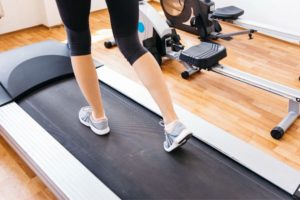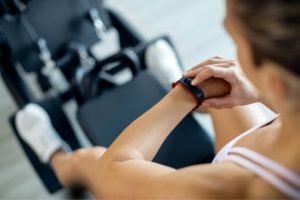One major advantage of running on treadmills is that they provide instrumental data and measurements.

These data can help track your progress toward achieving your fitness goal.
This is why many people prefer the treadmill for cardio workouts instead of the outdoors.
If the treadmill is your go-to equipment for running, you might have questioned the accuracy of the data it provides.
This post explores how accurate treadmills are in calculating different metrics and the factors that may impact the accuracy.
How Does a Treadmill Calculate Its Metrics and Their Accuracy
Most treadmills calculate different metrics, including calories or fat burned, distance, speed, and time.
The accuracy of these data is still being disputed. Here is all you need to know about their accuracy.
Distance Measurement
Treadmills typically measure distance based on the number of movements made by the belt.
Most treadmills are accurate to within 1-2% of the actual distance. However, some cheaper models may have a larger margin of error.
Also, if the user runs with an uneven gait, the distance measurement may not be entirely accurate.
Speed Measurement
Treadmills use a speed sensor to measure the speed of the belt. Again, most treadmills are accurate and are usually with 1-2% of the actual speed.
However, the accuracy can be affected by factors such as user weight and gait, as well as the condition of the treadmill.
Time Measurement
Treadmills are generally very accurate in tracking the duration of your workout.
They operate a built-in timer that starts and stops based on the movement of the belt.
Error on the user’s part can affect the accuracy of time measurement. This includes forgetting to press the stop button or pausing the timer,
Calorie Burned
Although the speed, time, and distance readings are pretty accurate, the same cannot be said of the calorie counter.
In calculating calories burned on a treadmill, a few factors are considered:
the user’s weight, height, gender, age, body fat percentage, and fitness level.
The calorie counter is programmed to calculate the metabolic rate of an average exerciser.
This is not specific to the individual since not everyone burns the same calories in the same amount of time.
Besides, providing incorrect information can skew the calculations slightly and cause the treadmill to give an inaccurate reading.
The calorie information is just an estimate and not completely reliable.
Treadmills can overestimate or underestimate the calorie burn by a few percent.
Does It Matter How Accurate a Treadmill Is?
The importance of the accuracy of a treadmill depends on the priority of the runner.
This information might be important for a runner using the treadmill to train for a specific goal.
A runner might want to know precisely how fast they run and gauge their overall improvement.
Some runners might be calculating the amount of time it takes them to run a mile.
Moreover, If weight loss is your goal, you might be more preoccupied with the calorie counter.
The treadmill accuracy is vital if you like to keep tabs on your performance.
Factors That Can Affect a Treadmill’s Accuracy.
The level of accuracy can vary depending on several factors.
Calibration
The accuracy of a treadmill can be affected if it is not properly calibrated. Therefore, a treadmill should be calibrated periodically.
This ensures that the speed and distance measurements are accurate.
Belt Tension
The tension of the treadmill belt can also affect its accuracy.
If the belt is too loose or tight, it can affect the speed and distance measurements.

Motor Performance
If the motor is not functioning correctly, it can affect the accuracy of the speed and distance measurements.
User’s Error
The weight and stride length of the user can also affect the accuracy of the treadmill.
Maybe the user is significantly heavier or has a longer stride length than the average user.
These factors can affect the accuracy of the speed and distance measurements.
The Surface Inclination
The angle of the treadmill’s surface can also affect its accuracy.
If the surface is not level, it can affect the speed and distance measurements.
Temperature and Humidity of the Room
The temperature and humidity in the room where the treadmill is fixed also play a role in its accuracy.
Every treadmill has its recommended range of temperature.
Failure to maintain this can affect the performance of the treadmill’s components, like the motor and belt.
This can, in turn, affect its accuracy.
The Brand and Type of the Treadmill
Each treadmill manufacturer has their own formulas that they input into the machine.
Therefore, some treadmill brands are more accurate than others.
Commercial-grade treadmills, for instance, are usually more accurate than home treadmills.
The reason is they are manufactured with higher standards and stricter accuracy requirements.
Despite this, one cannot say definitively that any treadmill is 100% accurate.
Condition of the Treadmill
Like any other machine, the condition of the treadmill can affect its accuracy.
An old treadmill may not perform as accurately as a newer version. The same goes for a treadmill that has not been properly maintained.
Using a treadmill over time can also cause it to lose calibration. For instance, a treadmill belt will sustain slight wear and tear over time.
It can stretch the belt slightly, causing the treadmill to give a somewhat inaccurate distance reading.
How to Ensure the Accuracy of Your Treadmill
Check the Type of Treadmill You Buy
If the accurate readings of the treadmill are important to you, you could consult the manufacturer or a treadmill expert.
Also, with a little bit of research, you will find a high-quality treadmill that meets your accuracy needs.
Proper Calibration
Treadmills need to be calibrated periodically to ensure accuracy.
Calibration involves examining the accuracy of the speed and distance measurements and adjusting them if necessary.
Most high-end treadmills have an automatic calibration feature. Other lower-end models may require manual calibration.
This can usually be done by following the manufacturer’s instructions in adjusting the tension or alignment of the belt.
Some high-quality treadmills offer free ” recalibration” per year.
It might be challenging to do this if you run on a treadmill you do not own.
In this case, you should first inform the owner, such as the fitness center.
Regular Maintenance
Maintaining your treadmill ensures that your treadmill remains accurate over time.
Maintenance may involve lubricating the belt, cleaning the machine, and tightening any loose bolts or screws.
Additionally, Inspect your treadmill for any signs of wear and tear or damage.
Use External Measurements
If you can access them, use external measurement tools, such as a stopwatch or fitness tracker.
They can be particularly useful for tracking time or distance.
You can compare your treadmill’s readings to these measurements, using it to double-check.
This way, you are getting an accurate picture of your progress.

Summary
Treadmill accuracy can vary depending on the type of treadmill.
Generally, treadmills are considered accurate in measuring distance, speed, and time.
However, they are quite lacking when it comes to calculating calories burned.
The level of accuracy can fluctuate depending on several factors.
While working out, remember to take the numbers with a grain of salt.
Even on a well-calibrated treadmill, you can’t completely rely on the information a treadmill gives.

Some people collect expensive old cars, and I’m into collecting bikes. I have 15 different bikes: special mountain bikes, sportbikes, professional, amateur, and city bikes. My friends and colleagues call me a ‘bike expert’ because I give advice on how to choose the right bike.
I’m also a massive fan of gym culture and heavyweight workouts. I met Alan at my local gym, and we’ve become friends quite soon. His idea of starting a sports blog seemed interesting to me, so I agreed to help.





